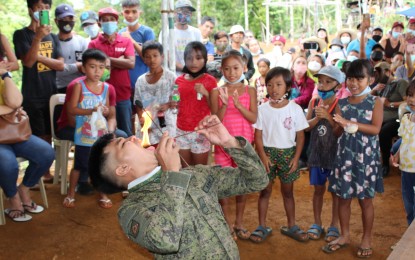
REACHING OUT TO REMOTE VILLAGES. A soldier entertains children during a service caravan in Balangkayan, Eastern Samar in this July 8, 2021 photo. The delivery of services along with combat operations is effective in clearing communities from the threats of the New People's Army in the Eastern Visayas region. (Photo courtesy of Philippine Army)
TACLOBAN CITY – At least 213 villages in Eastern Visayas have been cleared of New People’s Army (NPA) influence from 2019 to mid-2021, covering the first two years of employing the “whole-of-nation” approach in wiping out the communist terrorist group.
Of the 213 villages, 94 are in Samar province, 45 in Eastern Samar, 41 in Leyte, 29 in Northern Samar, and four in Southern Leyte.
There are still 126 villages in Northern Samar and 29 villages in Eastern Samar with ongoing clearing activities by the Regional Task Force to End Local Communist Armed Conflict (RTF-ELCAC).
“The Philippine Army, partner national government agencies, and local government units hope to fully rid these villages in Northern and Eastern Samar from the NPA influence by September this year,” said Capt. Ferdinand Tutanes, RTF-ELCAC desk officer of the Philippine Army’s 8th Infantry Division in a phone interview Monday.
There are still 97 villages in Northern Samar eyed for implementation of the retooled community support program (RCSP) between the last quarter of 2021 to early 2022.
RCSP is a strategy that deploys teams tasked to identify issues and concerns in remote communities threatened by the NPA.
These issues will be raised to the concerned government agencies and local government units to be addressed accordingly.
The task of the teams is to facilitate solutions for those identified problems through the convergence of efforts of different government agencies supervised by the local task force on ending local communist armed conflict.
“What is unique about Eastern Visayas is our RCSP implementation. While our troops are engaged in combat operations, our partner agencies had dialogues with villagers to identify their needs and deliver basic services to them. It only takes three months for us to clear a village affected by insurgency through this whole-of-nation approach,” Tutanes added.
In an earlier interview, Maj. Gen. Pio Diñoso III, commander of the Philippine Army’s 8th Infantry Division, said they expect the war against the NPA to be bloodier.
The remaining members of the NPA are no longer organized, but they still exist to continue their extortion activities and spread the communist ideology, according to the official.
“We are almost done with our campaign. We should expect this to be more violent since NPA members are already fighting for survival. They want to project that they are still strong,” Diñoso told the Philippine News Agency (PNA).
The weakening of NPA in Eastern Visayas is a result of a whole-of-nation approach by linking arms between basic service providers from the central government, community participation groups from the local governments, and the security sector from the military and police.
In support of the fight against NPA, several local government units have formed their task force ELCAC operationalizing Executive Order 70 issued by President Rodrigo Duterte on Dec. 4, 2018.
The directive also institutionalizes a “whole-of-nation approach” in attaining an inclusive and sustainable peace.
The Communist Party of the Philippines-NPA, which has been waging a five-decade armed struggle against the government is listed as a terrorist organization by the United States, the European Union, the United Kingdom, Australia, Canada, New Zealand, and the Philippines. (PNA)
